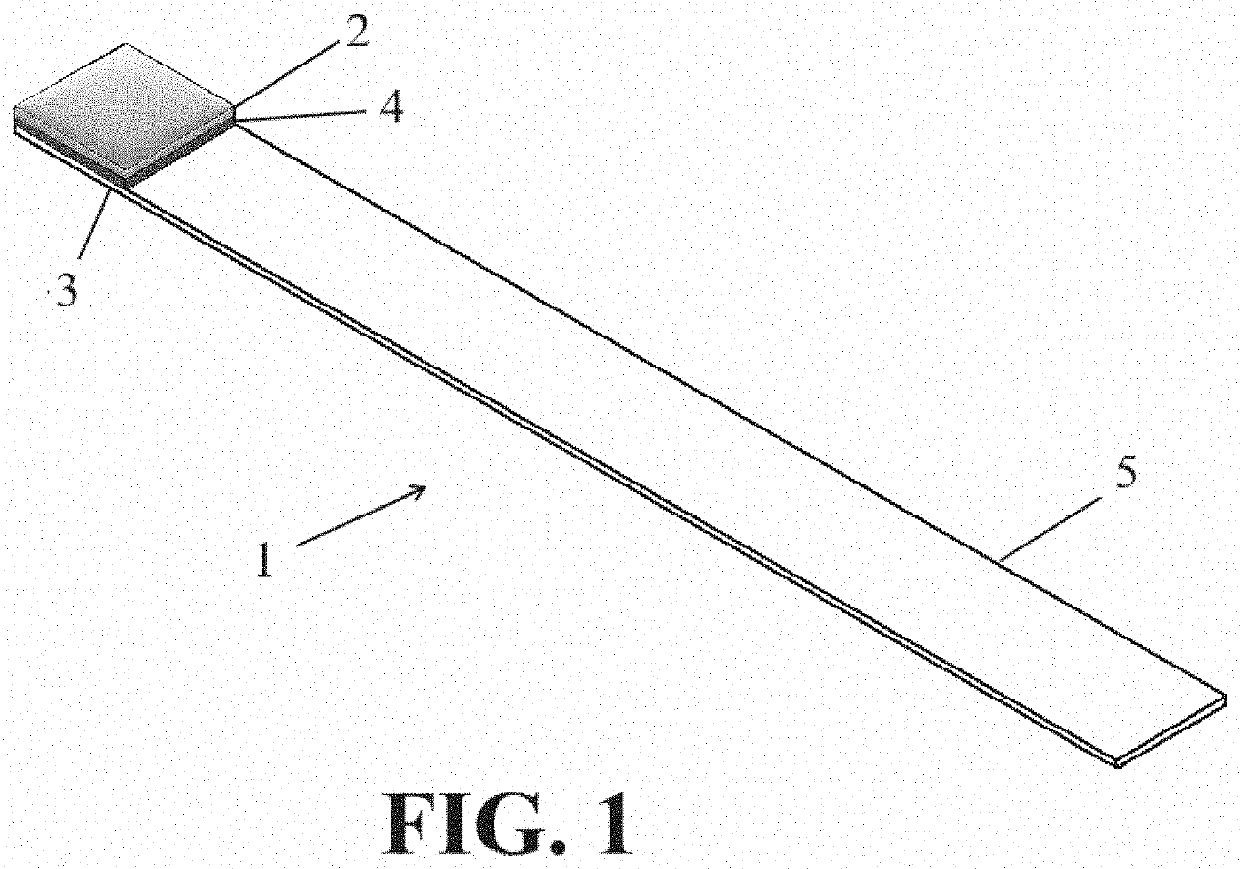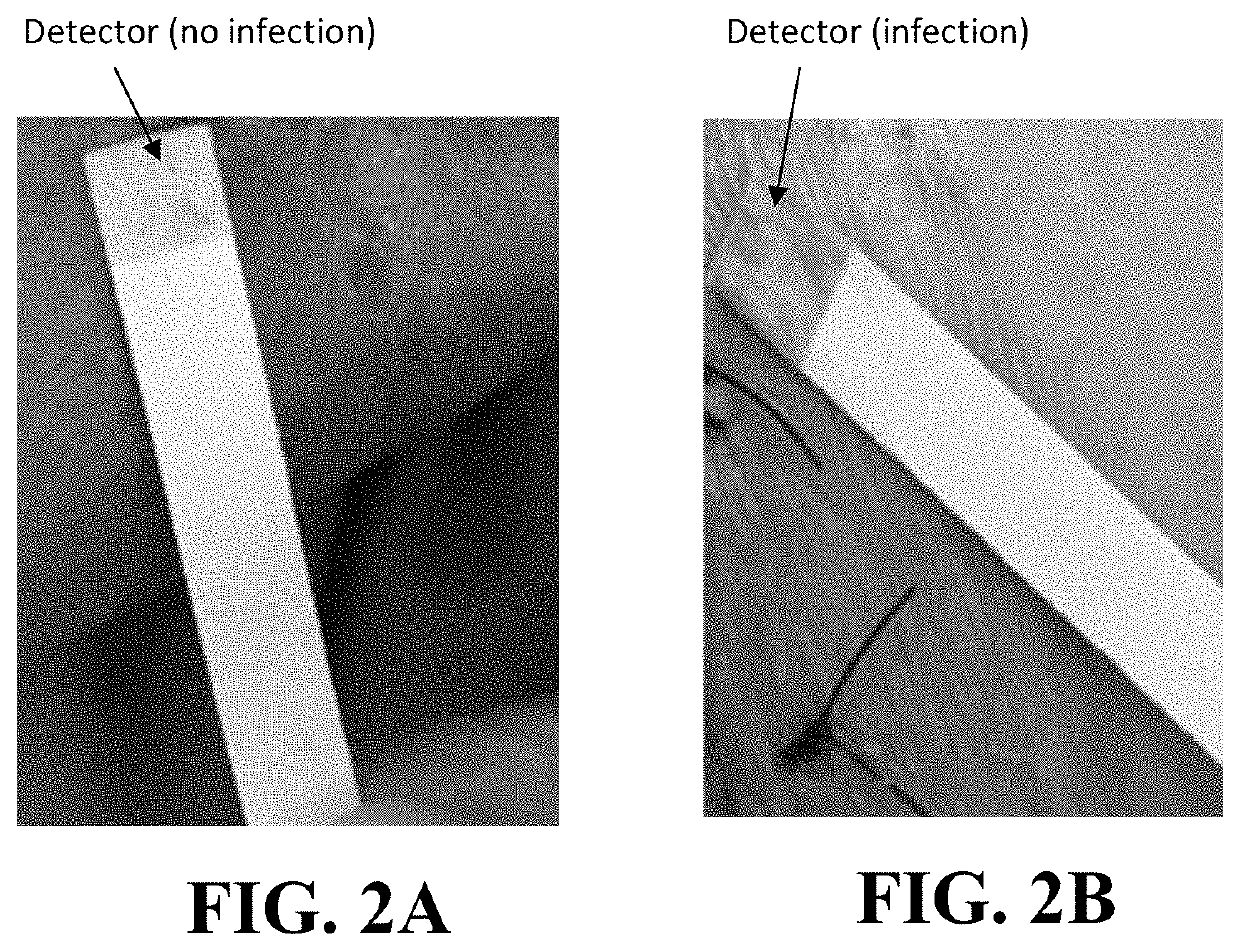Infection detection device and method using same
a detection device and technology of infection, applied in the field of test strips, can solve the problems of inability to quickly diagnose wounds and urine infections, inability to quickly and efficiently solve problems such as time-consuming, and rarely heal quickly or without complications, and achieve the effects of facilitating decision-making, rapid operation, and efficient and cheapness
- Summary
- Abstract
- Description
- Claims
- Application Information
AI Technical Summary
Benefits of technology
Problems solved by technology
Method used
Image
Examples
example 1
Fabrication of a Test Strip
[0042]In accordance with a preferred embodiment shown in FIG. 1, a test strip 1 was manufactured using a detector 2. The detector consisted of a filter paper impregnated with a sensing solution including 3% (w / v) gelatin and 0.1% (w / v) bromethymol blue. A cardboard was used as the base layer 3, and a double sided adhesive as the adhesive layer 4. The filter paper (Whatman® qualitative filter paper, Grade 1) had a thickness preferably of about 0.26 mm, which was cut in shape of a square of about 7 mm length and 7 mm width. The base layer 3 was made of a cardboard with a thickness preferably of about 0.5 to 1 mm, which was cut into a rectangle of 70 mm length and 7 mm width. The adhesive layer 4 (Nano Tape, adhesive type: Cellulose) was a double sided adhesive cut into a rectangle of 7 mm length and 7 mm width. The impregnated filter paper (detector 2) was then attached on the cardboard (base layer 3) using the double sided adhesive (adhesive layer 4). Plura...
example 2
Detection of Infection in Wounds
[0043]Fifty-one patients with chronic and acute wounds, not receiving antibiotic treatment within 7 days before the tests, were investigated. Wounds washed with sterile saline and then superficially contacted with the detector of the test strip. In case of an infection, upon contact, the color of the detector start changing rapidly from yellow to green and stabilizes within about 60 seconds. Wound swab cultures were collected and laboratory results were used as control group. Wounds with a growth of ≥105 colony forming unit (CFU) per ml was considered to have a positive culture (Lindsay et al., 2017). Among the 51 patients, 37 were found to have wound infection by both the laboratory and test strip. As was verified by laboratory tests, Staphylococcus aureus and Gram-positive cocci were the most prevalent pathogenic yield from the cultures. Other bacteria detected by cell culture laboratory and were involved with the infections detected by the test str...
example 3
Detection of Infection in Urine
[0046]In this study, urine specimens of 50 patients, with no antibiotic treatment, were examined for the urinary tract infections (UTIs), based on the presence of MMPs activity as an indicator of bacteriuria. The validity of the test strip results of patients with or without clinical symptoms of urinary tract infection (UTIs) was investigated by comparing the test strip results with those of their corresponding urine culture test as a control group.
[0047]Among the 50 patients, 3 were found to have UTIs by both the laboratory and the test strip. The accuracy, sensitivity, and specificity for the strip calculated against the urine culture for the diagnosis of UTIs, were 98%, 100%, and 97.9% respectively. All the results were significant (p≤0.01).
[0048]The bacteria involved with the urine infections that were detected by the strip and cell culture tests were Escherichia coli and Proteus vulgaris, where Escherichia coli was the most prevalent pathogenic yi...
PUM
 Login to View More
Login to View More Abstract
Description
Claims
Application Information
 Login to View More
Login to View More - R&D
- Intellectual Property
- Life Sciences
- Materials
- Tech Scout
- Unparalleled Data Quality
- Higher Quality Content
- 60% Fewer Hallucinations
Browse by: Latest US Patents, China's latest patents, Technical Efficacy Thesaurus, Application Domain, Technology Topic, Popular Technical Reports.
© 2025 PatSnap. All rights reserved.Legal|Privacy policy|Modern Slavery Act Transparency Statement|Sitemap|About US| Contact US: help@patsnap.com


